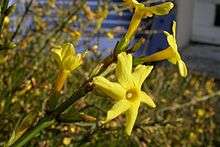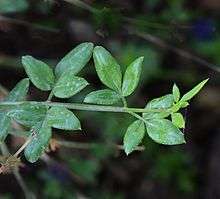Jasminum nudiflorum
| Winter jasmine | |
|---|---|
 | |
| Jasminum nudiflorum | |
| Scientific classification | |
| Kingdom: | Plantae |
| (unranked): | Angiosperms |
| (unranked): | Eudicots |
| (unranked): | Asterids |
| Order: | Lamiales |
| Family: | Oleaceae |
| Genus: | Jasminum |
| Species: | J. nudiflorum |
| Binomial name | |
| Jasminum nudiflorum Lindl. | |
| Synonyms | |
| |
Winter jasmine (Jasminum nudiflorum) is a slender, deciduous shrub native to China (Gansu, Shaanxi, Sichuan, Xizang (Tibet), Yunnan). It is widely cultivated as an ornamental and is reportedly naturalized in France and in scattered locations in the United States (Texas, Oklahoma, Georgia, Tennessee, Maryland and New Jersey).[2][3][4]
Description

It grows to 3 m (10 ft) tall and wide,[5] with arching green shoots and opposite, pinnate, dark green leaves. Each leaf is divided into three oval-oblong leaflets which are about 3 cm long.[4][6]
As its name suggests, in the Northern Hemisphere winter jasmine flowers from November to March. The solitary flowers, often appearing on the bare stems (hence the Latin nudiflorum, literally "naked flower")[7] have six petals and are bright yellow, or white, about 1 cm across, appearing in the leaf axils. It likes full sun or partial shade and is hardy.
Jasminum nudiflorum is valued by gardeners as one of the few plants that are in flower during the winter months. It is frequently trained against a wall to provide extra warmth and shelter,[8] but also lends itself to groundcover.[5] It tolerates hard pruning and should be pruned in spring immediately after flowering; regular pruning will help to prevent bare patches. It can also be grown as a bonsai and is very tolerant of the wiring methods. It can be propagated using the layering technique.
Taxonomy
It is known as rui guo yuan wei in Pidgin.[9]
It is also known as 'jasmim-amarelo' in Portuguese (Brazil) and 'vinterjasmin' in Swedish.[9]
It was collected in China by Robert Fortune.[10]
It was first published and described by Lindl. in the Journal of the Horticultural Society of London Vol.1 on page 153 in 1846.[9][11]
It was verified by United States Department of Agriculture and the Agricultural Research Service on 30 September 2011.[9]
Jasminum nudiflorum has gained the Royal Horticultural Society's Award of Garden Merit.[12]
Distribution and habitat
Range
It is found within many Provinces of China, (including Guangxi (Gansu), Shanxi, Sichuan, Xizang (also referred to as Tibet) and Yunnan.[9]
References
- ↑ "Jasminum nudiflorum Lindl. is an accepted name". theplantlist.org (The Plant List). 23 March 2012. Retrieved 5 August 2015.
- ↑ Kew World Checklist of Selected Plant Families, Jasminum nudiflorum
- ↑ Biota of North America Program, Jasminum nudiflorum
- 1 2 Flora of China v 15 p 311, Jasminum nudiflorum
- 1 2 RHS A-Z encyclopedia of garden plants. United Kingdom: Dorling Kindersley. 2008. p. 1136. ISBN 1405332964.
- ↑ Lindley, John. 1846. Journal of the Horticultural Society of London 1: 153–154 Jasminum nudiflorum
- ↑ Harrison, Lorraine (2012). RHS Latin for gardeners. United Kingdom: Mitchell Beazley. p. 224. ISBN 9781845337315.
- ↑ "PFAF Database - Jasminum nudiflorum". Plants for a future. Retrieved 20 May 2013.
- 1 2 3 4 5 6 "Taxon: Jasminum nudiflorum Lindl.". ars-grin.gov (Germplasm Resources Information Network). Retrieved 5 August 2015.
- ↑ Nicholson, B.E.; Wallis, Michael (1963). The Oxford Book of Garden Flowers (Revised ed.). London: Oxford University Press (published 1973). p. viii. ISBN 1131802403.
- ↑ "Oleaceae Jasminum nudiflorum Lindl.". ipni.org (International Plant Names Index). Retrieved 5 August 2015.
- ↑ "RHS Plant Selector - Jasminum nudiflorum". Royal Horticultural Society. Retrieved 20 May 2013.
Other sources
- Aldén, B., S. Ryman & M. Hjertson. 2009. Våra kulturväxters namn - ursprung och användning. Formas, Stockholm (Handbook on Swedish cultivated and utility plants, their names and origin).
- Chinese Academy of Sciences. 1959–. Flora reipublicae popularis sinicae.
- Erhardt, W. et al. 2008. Der große Zander: Enzyklopädie der Pflanzennamen.
- Green, P. S. 1965. Studies in the genus Jasminum III: The species in North America. Baileya 13:153.
- Groth, D. 2005. pers. comm. [re. Brazilian common names].
- Hanelt, P., ed. 2001. Mansfeld's encyclopedia of agricultural and horticultural crops. Volumes 1-6.
- Huxley, A., ed. 1992. The new Royal Horticultural Society dictionary of gardening.
- Komarov, V. L. et al., eds. 1934–1964. Flora SSSR.
- Krüssmann, G. 1984. Manual of cultivated broad-leaved trees and shrubs (English translation of Handbuch der Laubgehölze. 1976).
- Tutin, T. G. et al., eds. 1964–1980. Flora europaea.
- Walters, S. M. et al., eds. 1986–. European garden flora.
- Wu Zheng-yi & P. H. Raven et al., eds. 1994–. Flora of China (English edition).
External links
| Wikimedia Commons has media related to Jasminum nudiflorum. |
- Missouri Botanical Garden, Plant Finder, Gardening Help, Jasminum nudiflorum
- Plants for a Future, Jasminum nudiflorum
- Royal Horticultural Society Plant Selector, Jasminum nudiflorum
- FloraData 657, Jasminum nudiflorum
- Hauenstein-rafz, Winter-Jasmin, Jasminum nudiflorum